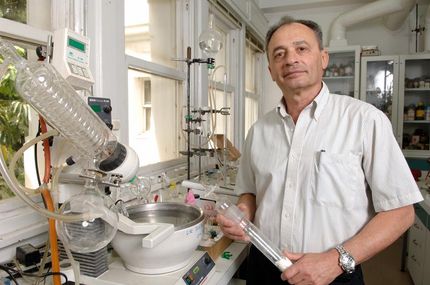Bio-enabled, surface-mediated approach produces nanoparticle composites
Using thin films of silk as templates, researchers have incorporated inorganic nanoparticles that join with the silk to form strong and flexible composite structures that have unusual optical and mechanical properties. This bio-enabled, surface-mediated formation approach mimics the growth and assembly processes of natural materials, taking advantage of the ability of biomolecules to chemically reduce metal ions to produce nanoparticles without harsh processing conditions.
Less than 100 nanometers thick, silk-silver nanoparticle composite films formed in this process can be used for flexible mirrors and films that reflect light in specific wavelengths. The technique could also be used to create anti-microbial films, thin film sensors, self-cleaning coatings, catalytic materials and potentially even flexible photovoltaic cells.
"We are taking advantage of biological molecules that have the ability to bind metallic ions of silver or gold from solution," said Vladimir Tsukruk, a professor in the School of Materials Science and Engineering at the Georgia Institute of Technology. "These molecules can create mono-dispersed metallic nanoparticles of consistent sizes under ambient conditions – at room temperature and in a water-based environment without high vacuum or high temperatures.
The nanoparticles produced range in size from four to six nanometers in diameter, surrounded by a biological shell of between one and two nanometers. The silk template permits good control of the nanoparticle placement, creating a composite with equally dispersed particles that remain separate. The optical properties of the resulting film depend on the nanoparticle material and size.
"This system provides very precise control over nanoparticle sizes," said Eugenia Kharlampieva, a postdoctoral researcher in Tsukruk's laboratory. "We produce well-defined materials without the problem of precipitation, aggregation or formation of large crystals. Since the silk fibroin is mono-dispersed, we can create uniform domains within the template."
Fabrication of the nanocomposites begins by dissolving silk cocoons and making the resulting fibroin water soluble. The silk is then placed onto a silicon substrate using a spin-coating technique that produces multiple layers of thin film that is then patterned into a template using a nanolithography technique.
"Because silk is a protein, we can control the properties of the surface and design different kinds of surfaces," explained Kharlampieva. "This surface-mediated approach is flexible at producing different shapes. We can apply the method to coat any surface we want, including objects of complex shapes."
Next, the silk template is covered with a solution containing ions of gold, silver, or other metal. Over a period of time ranging from hours to days, the nanoparticles form within the template. The relatively long growth time, which operates at room temperature and neutral pH in a water-based environment, allows precise control of the particle size and spacing, Tsukruk noted.
"We operate at conditions that are suitable for biological activities," he said. "No reducing agents are required to produce the particles because the biomolecules serve as reducing agents. We don't add any chemicals that could be toxic to the protein."
Use of these mild processing conditions reduces the cost producing the composites and their potential environmental impact. When dried, the resulting silk-nanoparticle film has high tensile strength, high elasticity and toughness.
"Silk is almost as strong as Kevlar, but it can be deformed by 30 percent without breaking," said Tsukruk. "The silk film is very robust, with a complicated structure that you don't find in synthetic materials."
For the future, the researchers plan to use the bio-assisted, surface-mediated technique to produce nanoparticles from other metals. They also hope to combine different types of particles to create new optical and mechanical properties.
"If we combine gold-binding and silver-binding peptides, we can make composites that will include a mixture of gold and silver nanoparticles," said Kharlampieva. "Each particle will have its own properties, and combining them will create more interesting composite materials."
The researchers also hope to find additional applications for the films in such areas as photovoltaics, medical technology, and anti-microbial films that utilize the properties of silver nanoparticles.
Beyond Tsukruk and Kharlampieva, the research team has included Dmitry Zimnistky, Maneesh Gupta and Kathryn Bergman of Georgia Tech; David Kaplan of the Department of Biomedical Engineering at Tufts University, and Rajesh Naik of the Materials and Manufacturing Directorate of the Air Force Research Laboratory at Wright-Patterson Air Force Base.
"Nanomaterials grown under environmentally friendly conditions can be as good as synthetic materials that are produced under harsh conditions," Tsukruk added. "This technique allows us to grow very useful materials under natural conditions."
































































